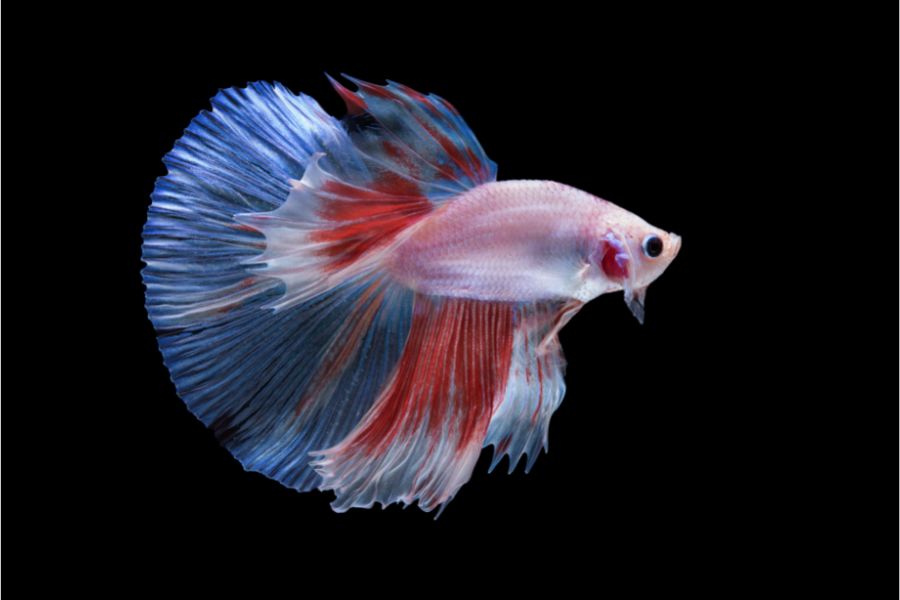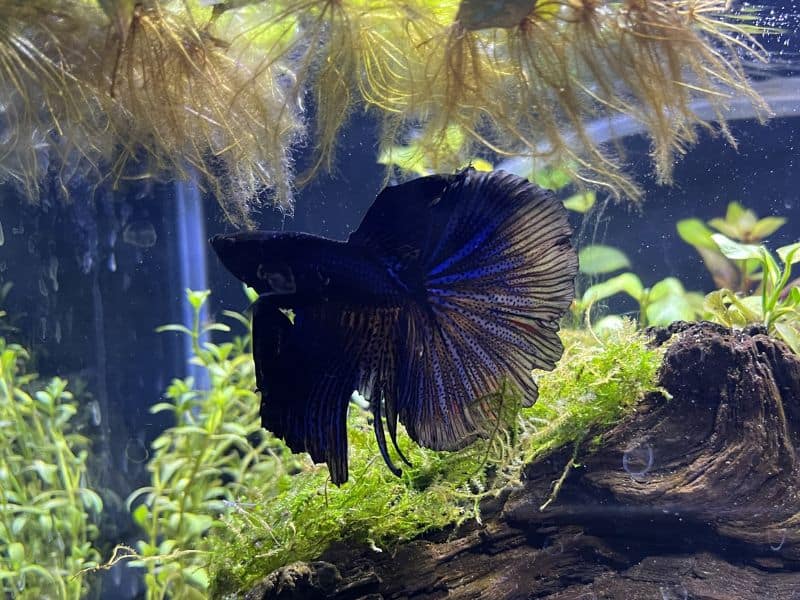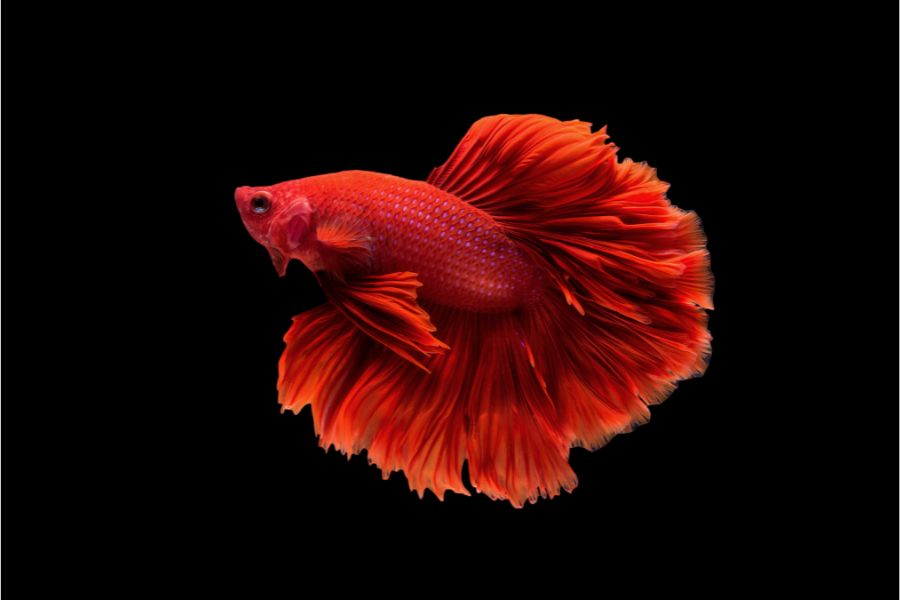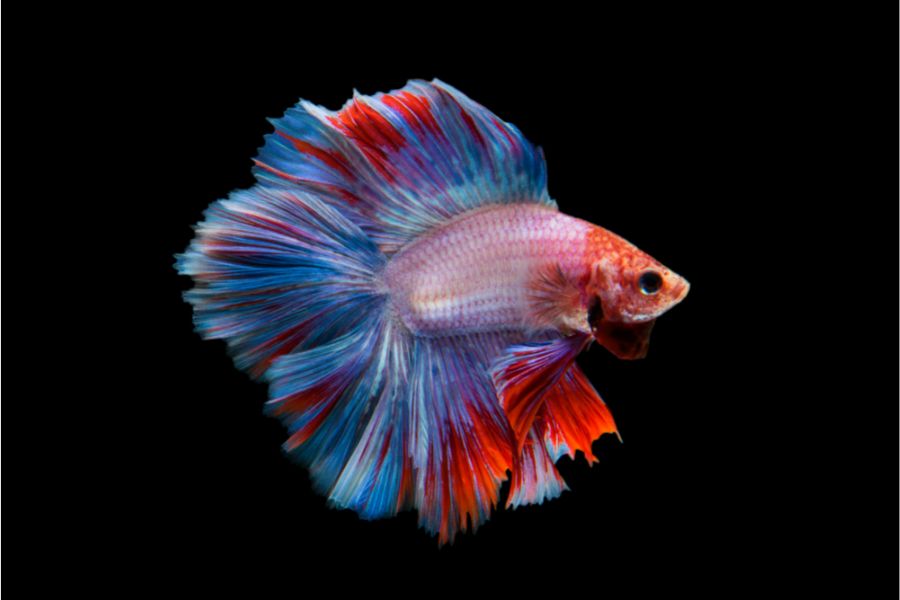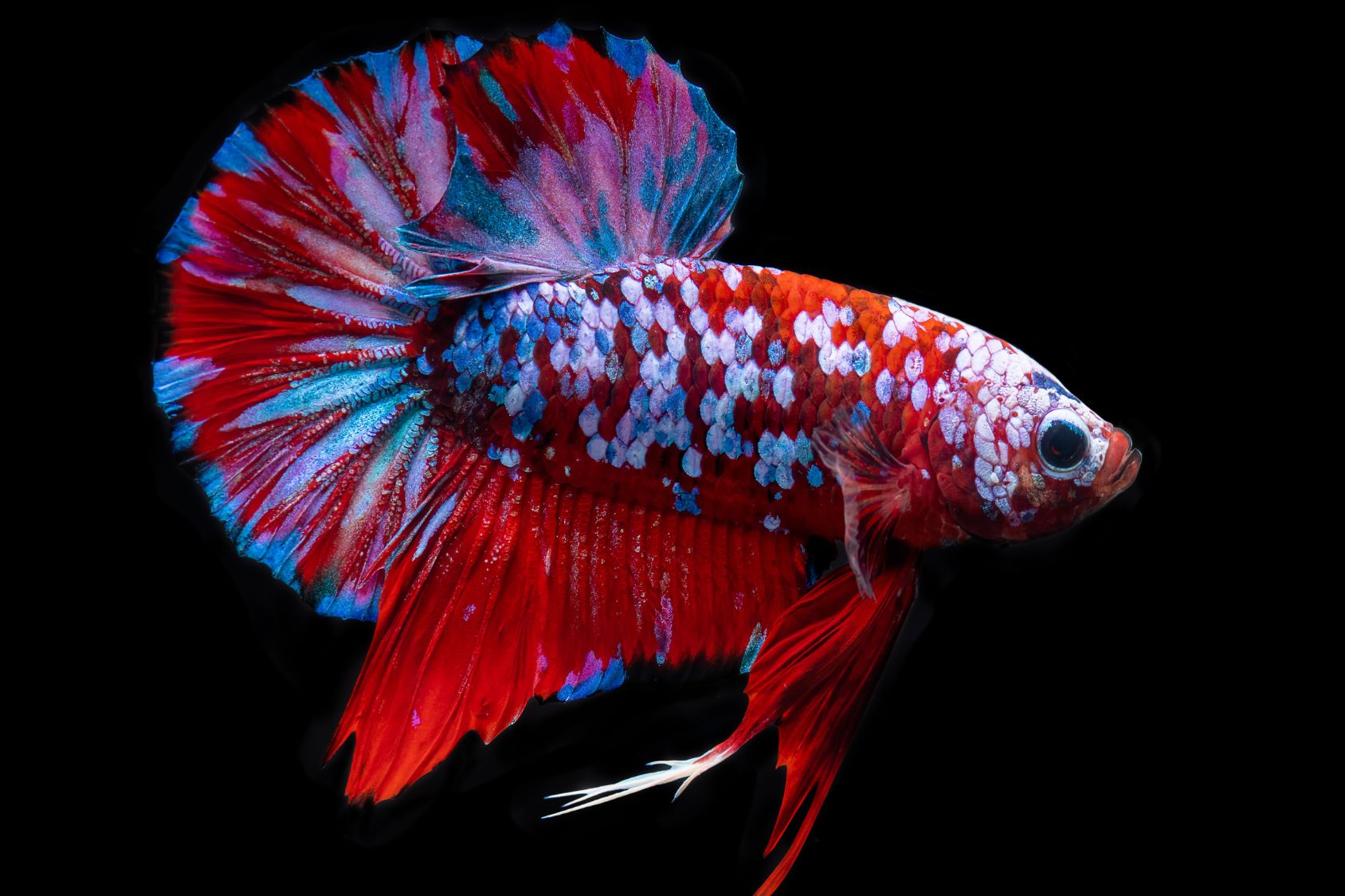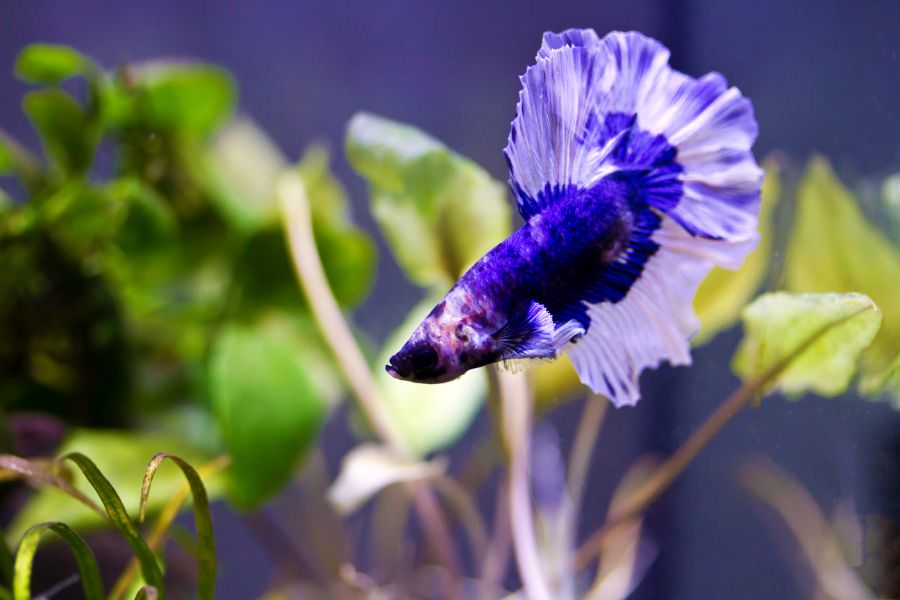Halfmoon Bettas are one of the most popular fishes in the aquarium hobby. Few other fishes have the same elegance, aesthetic appeal, and interesting personality that this species has. Not to mention that it can be a very hardy fish to keep.
But no matter how beautiful and low-maintenance a fish is, you still need to do your due diligence to make sure that they get the best kind of life under your care.
That’s why in this article, we’re going to discuss everything you need to know about the Halfmoon Betta fish; what it is, its most popular variants, how to take care of it, and more!
What is a Halfmoon Betta Fish?
Bettas are beloved pets all over the world, but they actually originated in Thailand and can be found in nearby Southeast Asian countries.
Because of its distinctive appearance, bold personality, and hardiness, the Betta has been bred into countless varieties, all with different fin patterns and colorations. The Halfmoon Betta fish is one of the most popular varieties of this species.
A Halfmoon Betta fish is a fin variant of the Bettas. Male Halfmoons have a distinctive tail that forms a 180-degree arc, hence their name. The best specimens have a rounded, symmetrical half-moon shape and can feature an array of hues.
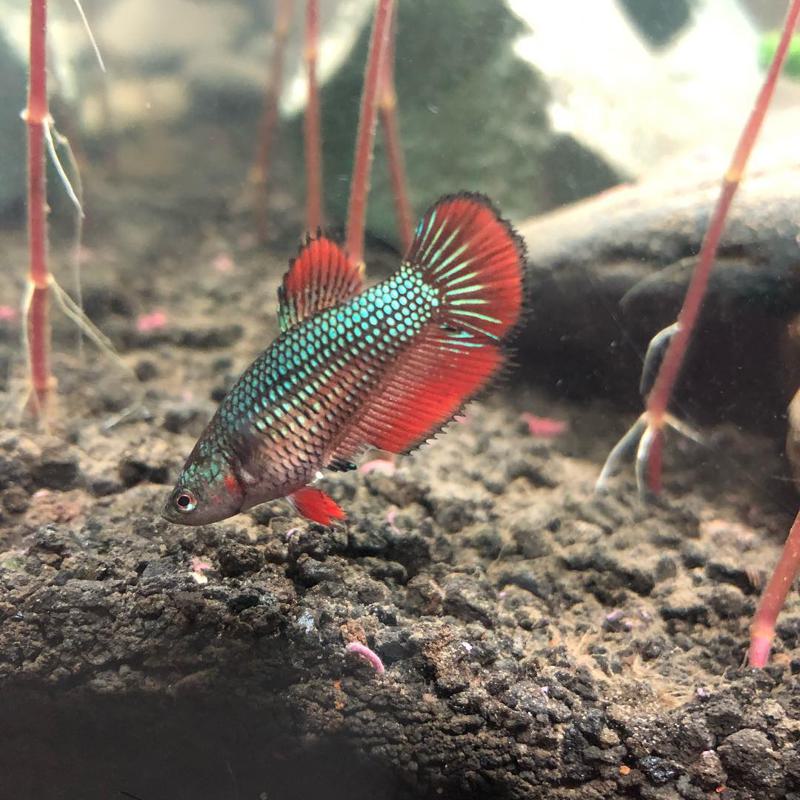
On the other hand, female Halfmoon Betta fish are smaller and with shorter fins.
Halfmoons sport everything that we love about the Betta: they have a variety of types and colors, an interesting individual personality, and are tough enough to tolerate a wide range of conditions.
Due to this, Halfmoon Bettas are popular for beginners and veteran aquarists alike. But no matter your level of experience, you still need to consider a few things when it comes to taking good care of them. That’s what we’re going to talk about in the next section.
Halfmoon Betta Fish Types
The Halfmoon Betta is one of the most popular Betta fish types, so there are plenty of subtypes to choose from. The variations are typically divided into two main types: color variants and tail variants.
It’s important to remember that these two variants can be combined together in one Betta. For instance, it’s entirely possible to find a Koi Rosetail Halfmoon, or a Dragonscale Dumbo Halfmoon.
In fact, many aquarists do this on purpose all the time in order to come up with a new, more exquisite variant.
Halfmoon Betta Tail Variants
Dumbo Halfmoon
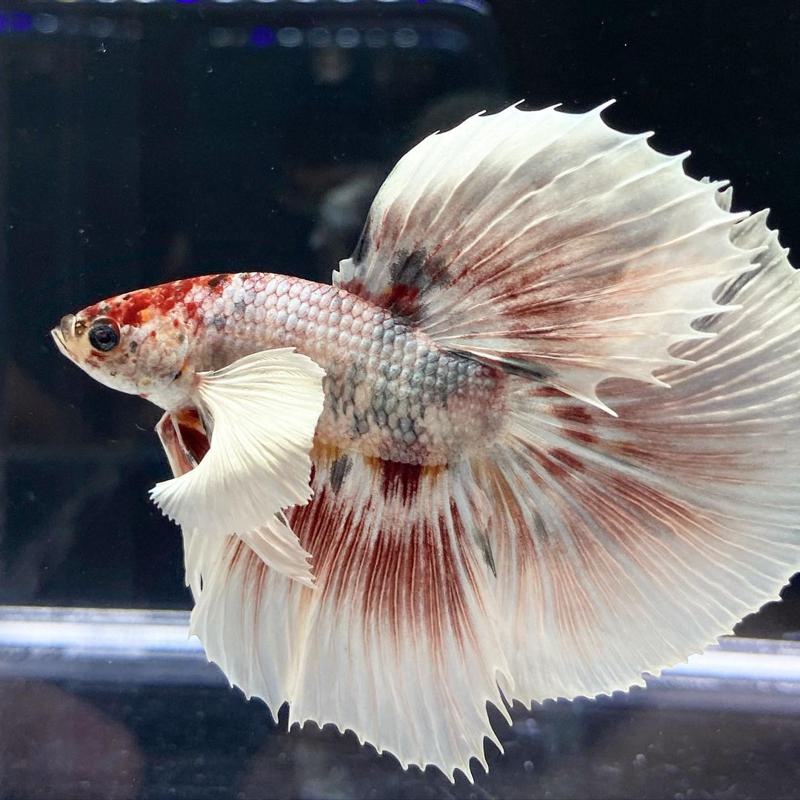
Whereas the previous varieties were mostly all about color patterns, the dumbo Halfmoon has more to do with the Betta’s body parts.
Also called the Halfmoon elephant ear Betta, the dumbo Halfmoon has exaggerated dorsal and pectoral fins. This gives them the effect of an elegant fish with overflowing fins and tails, making their appearance particularly striking.
Rosetail Halfmoon
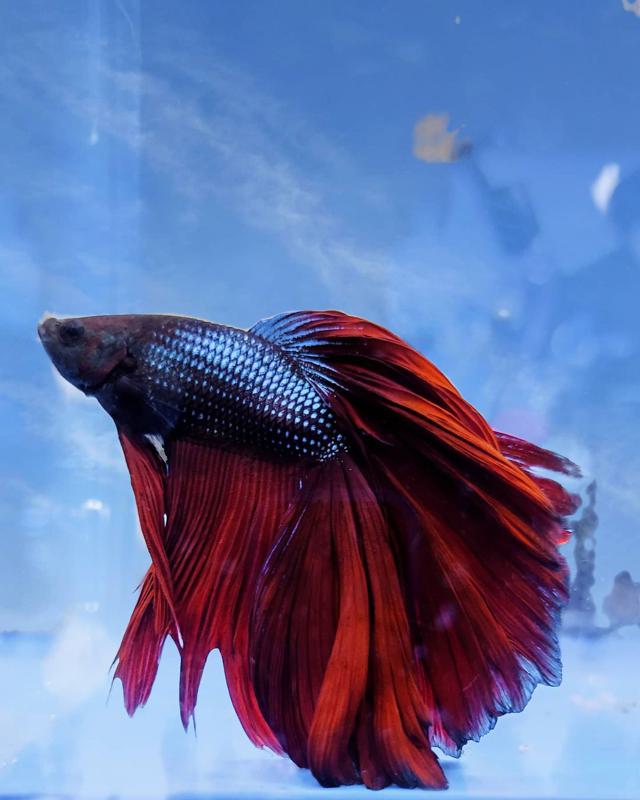
The distinguishing characteristic of a rosetail Halfmoon Betta is its elaborate tail fin. The folds and ruffles in their tail fins are enhanced through selective breeding, giving the adults an appearance reminiscent of their flower namesake.
Twintail Halfmoon
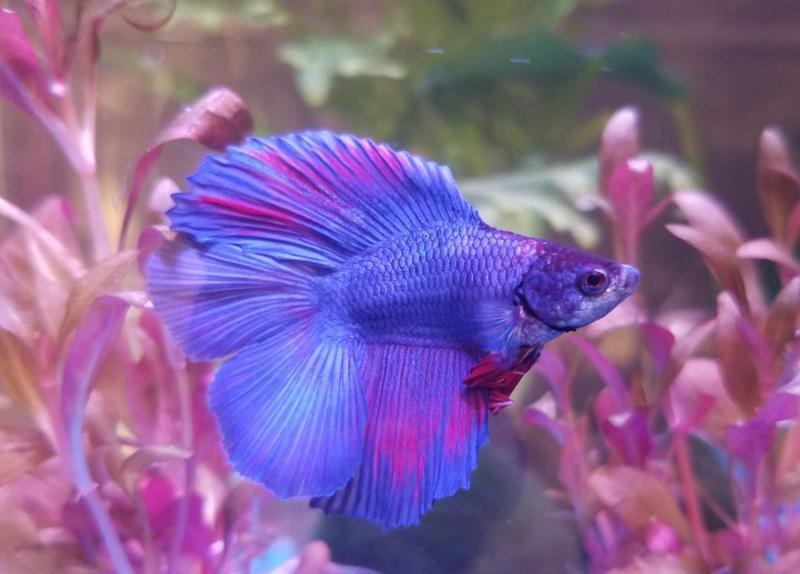
True to its name, the twintail Halfmoon Betta has a special characteristic that makes it look like its tail has been split in the middle.
This gives it the effect of having two tails, earning its other nickname, “half moon double tail Betta.” On the whole, though, the tails of this Betta still form the distinctive 180-degree arc when flared.
King Halfmoon
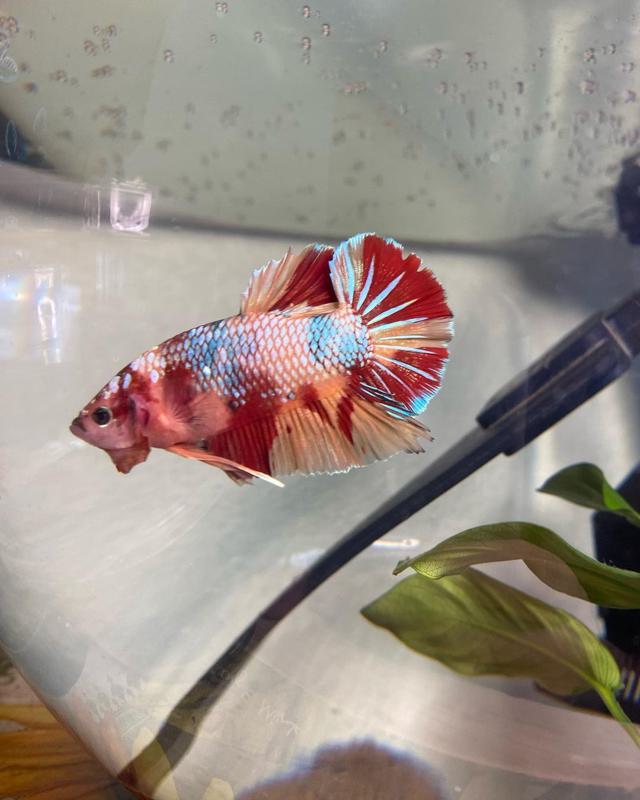
This variety of Halfmoon Betta is more unique than most because it’s a tail variation on a different kind of Betta.
The distinctive characteristics of the king Betta include having a larger body and smaller fin, giving it a sleeker and more dangerous look compared to the traditional flowy-finned Betta.
The king Halfmoon Betta still sports the distinctive 180-degree flare of the tail.
Over Halfmoon Betta
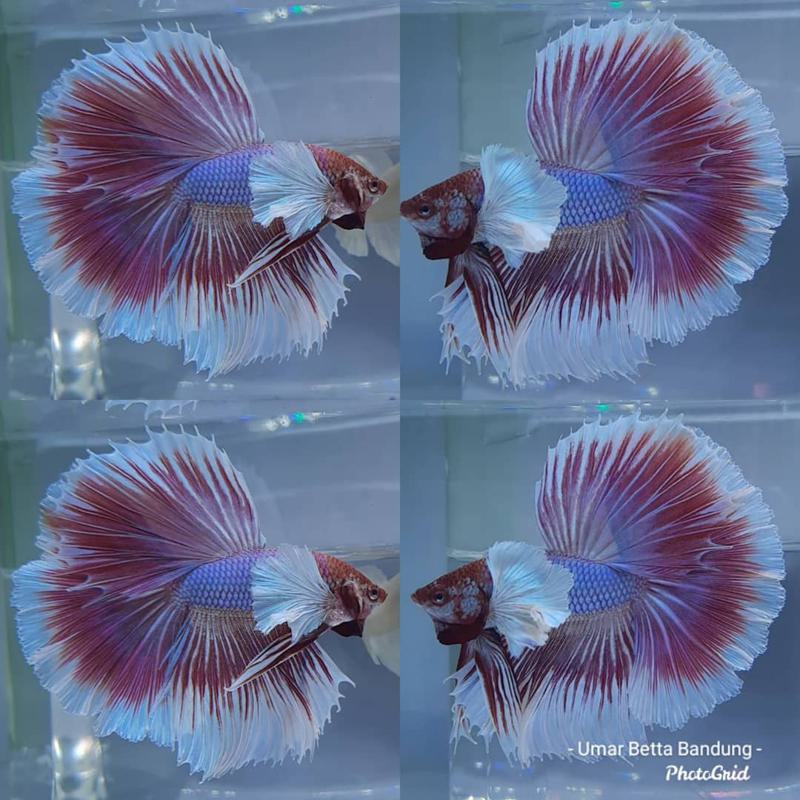
This Halfmoon Betta variation sports an extreme version of the Halfmoon. Rather than just sporting a 180-degree tail flare, the over Halfmoon goes beyond that, lending the fish an overdone and very elegant look.
Halfmoon Betta Color Variants
Solid-Colored Halfmoon
Solid-colored Halfmoon Bettas are very popular, both among hobbyists and breeders.
Just as its name suggests, Halfmoon Bettas of this type have a single solid color throughout their body.
Some of the most popular in this variety are the red Halfmoon Betta, white Halfmoon Betta, and blue Halfmoon Betta fish. There are also pure metallic colors, such as silver and bronze.
The colors that these Halfmoon Bettas displays are typically very vibrant, although they might not be equal across the body.
Bi-Colored Halfmoon
In contrast to the solid-colored Halfmoon Betta, the bi-colored sports two colors throughout its body. It’s one of the most common patterns that you can see in Bettas, but they can still create striking patterns that are widely appreciated in the aquarium world.
Dragonscale Halfmoon
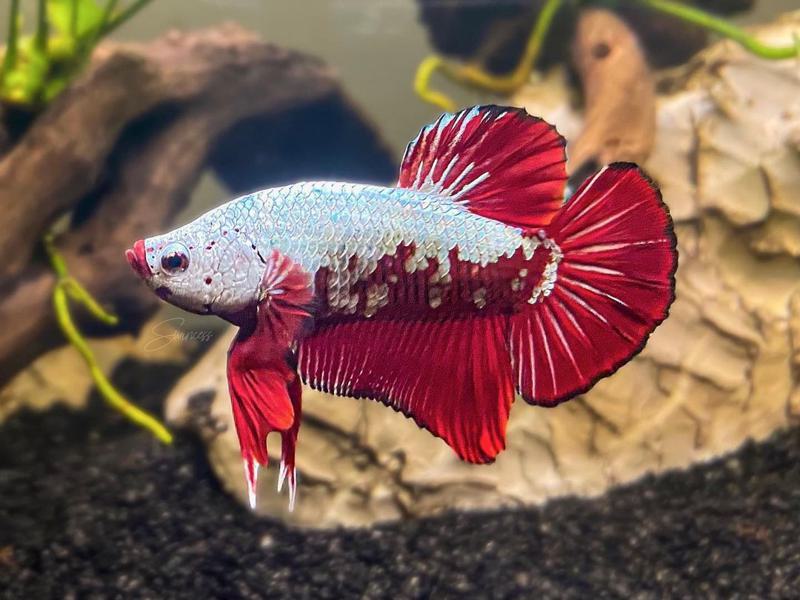
This is a relatively new variant of Halfmoon Bettas, attained by breeding wild Betta Mahachaiensis genes into regular aquarium Bettas. The result is bright, thick scales that look like dragon armor on the body of a Halfmoon Betta.
The results of this breeding are particularly striking, making dragon Bettas very sought-after in the Betta world.
Marble Halfmoon
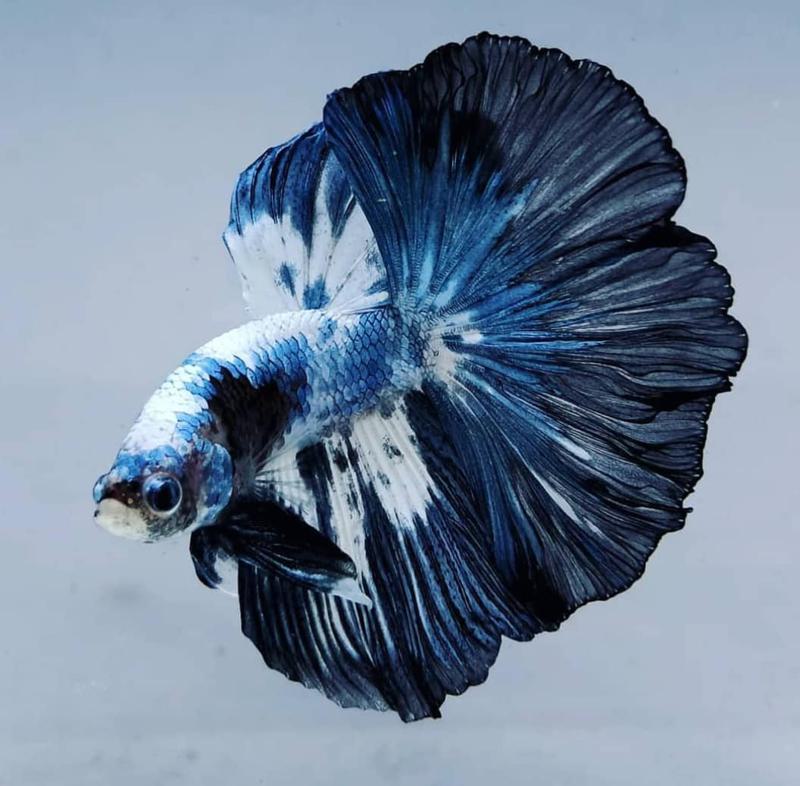
Like its name suggests, marble Halfmoon Betta fish have marble-like coloration, characterized by light body colors highlighted with vivid irregular patches of color.
This type of Betta fish is known to change its colors throughout the years, with bright patches of color developing from otherwise plain Betta body scales. The change can happen over months or years.
Marble Halfmoon Bettas have an interesting coloration and can complement any kind of Betta tank look.
Koi Halfmoon
Just like the marble pattern, the Halfmoon Koi Betta also sports many different and irregularly shaped colors. The only difference is that they’re colors that we would normally associate with koi, such as orange, white, black, and gray.
Mustard Gas Halfmoon
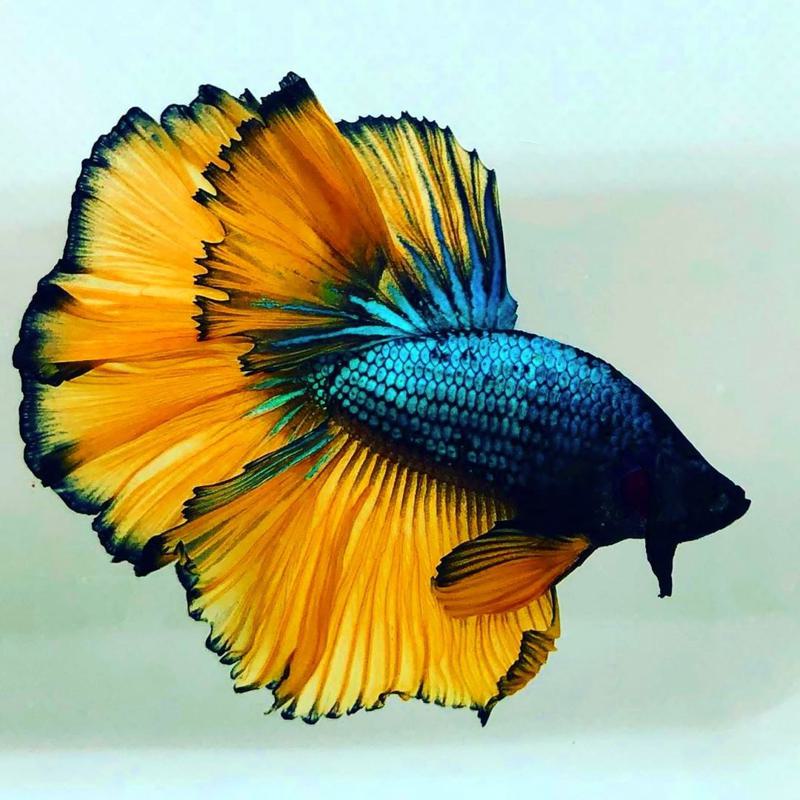
This color form of a Halfmoon Betta fish is another sought-after variety among Betta enthusiasts.
Mustard gas is a bi-color variety that is typically characterized by a combination of mustard yellow and another dominant color, often black, red, white, or blue.
Their body and the outer edge of their fins and tail are typically a solid dark color, often black. On the other hand, the mid-area of their fins and scales is the characteristic mustard-yellow color that gave this variety its name.
The mustard gas variety is also relatively rare and difficult to attain in breeding.
Butterfly Halfmoon
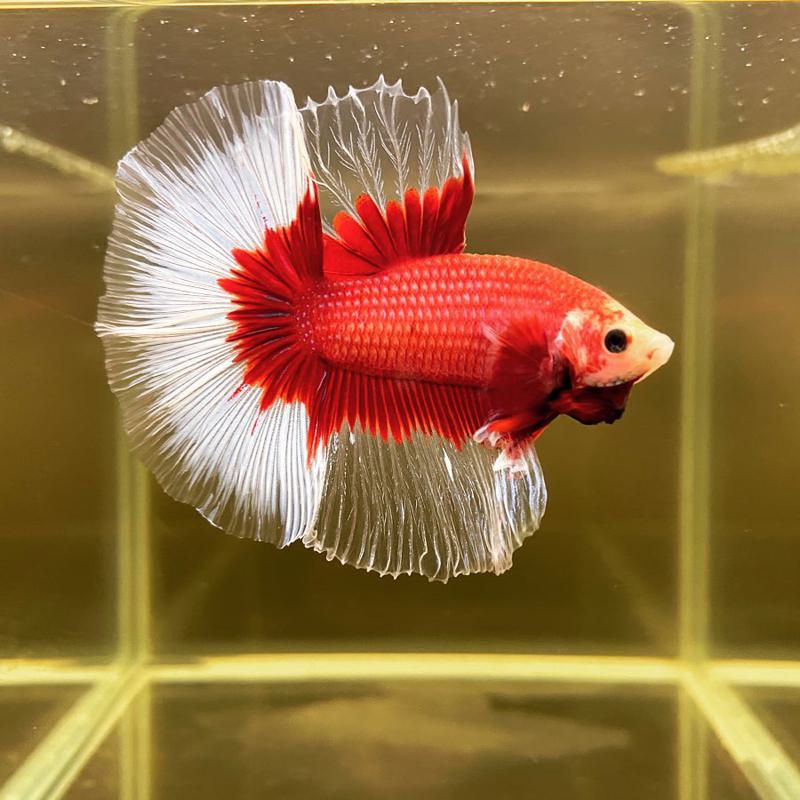
The butterfly Halfmoon Betta has a similar pattern to mustard gas Bettas; their tails and fins typically sport two colors, one light, and one dark. Their bodies are typically solid-colored with strikingly bright scales of blue, purple, red, and more.
They earned their name from the fanciful colors that they sport, looking like butterflies.
How to Take Care of a Halfmoon Betta Fish
Before you get too excited and start picking the most appealing Halfmoon Betta variation for you, you’ll need to study the most important factors involved in their care, which are the following.
Water Parameters
Halfmoon Bettas are not demanding when it comes to water parameters, and they can tolerate some water parameters that more sensitive fish might not be able to. Ideal water parameters for a Betta fish are the following.
- Temperature: 76-82°F (24-28°C)
- pH:5-7.5
- Hardness: Soft to moderate
- Ammonia: 0 ppm
- Nitrite: 0 ppm
- Nitrate: Less than 20 ppm
While Bettas aren’t demanding fishes, you should still ensure that the water parameters of your aquarium are within their range so that they don’t suffer.
Related: Best Water Temperature for Betta Fish
Tank Size and Setup
You can successfully raise Bettas in tanks 5 gallons and up, but the recommended tank size for a single male Betta is 10 gallons. This gives them ample space to explore, which is important for Bettas because of their curious nature.
Plants and decorations are optional — however, Bettas like to be stimulated, so having plants and a hardscape that mimics their natural habitat will make them happier.
Also Read: Betta Fish Tank Setup: What to Put In?
Behavior
Like any other Betta, Halfmoon Betta males are also very territorial and will likely attack other males within their immediate vicinity. Not only that, but they will also most likely hunt other fishes and creatures around them.
Thus, keeping a Halfmoon Betta in solitude in an appropriately-sized aquarium is often ideal.
If you want to keep male Bettas in a community aquarium, you need to make sure that there’s adequate space for all of them and that you pair your Betta with other fast-swimming species.
Feeding Halfmoon Betta Fish
While Bettas are omnivores, they also need a high-protein diet. In your aquarium, you can ensure that your Bettas are healthy by giving them a variety of food, such as the following.
- Pellets or flakes. Commercial Betta fish food is a balanced diet and provides all the necessary nutrients for your Betta to be healthy.
- Live or frozen food. Your Betta will appreciate a high-protein diet, so keep feeding them treats such as brine shrimp, daphnia, or bloodworms. Live food that they can hunt will also stimulate them.
- Bettas will also eat vegetables as long as they’re soft enough, such as blanched lettuce, spinach, or peas. Feeding your Betta vegetables can provide vitamins and fiber and can even help with indigestion.
It’s ideal for feeding Bettas once or twice per day, with enough food that they can consume in one minute.
Be careful about the quantity and frequency of your feeding, as Bettas are liable to overeat and get sick from it.
Breeding Halfmoon Betta Fish
It’s relatively simple to breed Halfmoon Bettas — the process is much like how you would breed Bettas normally. Here are the general steps you have to follow.
- Select your breeding pair. Choose a pair of healthy, sexually mature, and genetically diverse Bettas.
- Set up a breeding tank. A separate tank or container with proper water parameters and temperature is ideal as a breeding tank for your Bettas. Other than the right water parameters, adding cover and hardscape will make it easier on the female being chased.
- Condition the pair. Provide high-quality food and maintain optimal water conditions for 2-4 weeks before breeding to ensure the pair is in good health. Ensure they both don’t have any diseases or defects.
- Introduce the pair to each other. Gradually acclimate the male and female to each other’s presence and monitor their behavior. Ensure that the male doesn’t harass the female too much.
- Nest building. When the pair is ready to mate, the male will usually build a bubble nest at the surface of the water, which serves as a place for the female to lay her eggs.
- Spawning. The female will lay her eggs in the nest, and the male will fertilize them. The male will then care for the eggs and fry.
- Raise the fry. Provide proper nutrition and water conditions, and protect the fry from predation. Often, parent Bettas are caught and returned to their respective tanks at this point.
Breeding these fish can be tedious. It requires patience, attention to detail, and caring for your fish — but it can be very fulfilling if you do it successfully. Mastering the steps we talked about puts you at a good start.
Also Read: Crowntail Betta Fish
Halfmoon Betta Fish: FAQs
Are Halfmoon Bettas Rare?
Halfmoon Bettas are one of the most common varieties of Siamese fighting fish around, and common Halfmoon Betta fish prices are pretty cheap at any pet store.
However, they do sport rare varieties, such as the dragon Halfmoon Betta or mustard gas Halfmoon Betta.
What Is the Difference Between a Halfmoon Betta and A Regular Betta?
The most defining characteristic of Halfmoon Bettas is its tail which forms a complete 180-degree arc. Other varieties of Bettas don’t have that much flair in their tails or have a different tail structure.
What Are Ideal Tankmates for Halfmoon Bettas?
Male Halfmoon Bettas, like regular Bettas, can be very aggressive towards other Bettas, and even other species. Thus, small, peaceful, and preferably fast-moving tankmates are ideal for this fish. Examples include; snails, shrimps, danios, and more.
Final Words
Halfmoon Bettas are some of the most interesting and majestic-looking Betta fish variants, and there’s a lot to love in this type of fish.
Now that you’ve reached the end of this article, not only can you love and admire them — you can also care for them wholeheartedly!
As long as you follow the information in this article, your Halfmoon Bettas should live a wonderful life.
